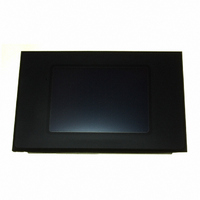20-101-0303 Rabbit Semiconductor, 20-101-0303 Datasheet - Page 81

20-101-0303
Manufacturer Part Number
20-101-0303
Description
SMARTSCREEN OP7100 W/TOUCHSCREEN
Manufacturer
Rabbit Semiconductor
Datasheet
1.101-0303.pdf
(126 pages)
Specifications of 20-101-0303
Display Type
STN - Super-Twisted Nematic
Viewing Area
121.00mm L x 91.00mm W
Backlight
CCFL - White
Dot Pitch
0.36mm x 0.36mm
Dot Pixels
320 x 240 (QVGA)
Interface
Serial
Product
Prototyping Accessories
Processor Type
Z180
Sram
128 KB
Flash
512 KB
Number Of I/os
16
Backup Battery
3 V Lithium Coin Type
Operating Voltage
10 V to 30 V
Power Consumption
4.5 W
Interface Type
Ethernet
Lead Free Status / RoHS Status
Lead free / RoHS Compliant
Display Mode
-
Dot Size
-
Lead Free Status / Rohs Status
Lead free / RoHS Compliant
Other names
20-101-0303
20-101-303
20-101-303
316-1175
20-101-303
20-101-303
316-1175
Keypad Programming
The sample program
rectory demonstrates how to read the keypad. Add the following directives at
the top of the program to make it possible to use the keypad routines.
Initialization
To initialize the keypad driver, call
formed before other keypad operations.
Scanning the Keypad
The function
keypad for changes. In a cooperative multitasking (big-loop style), this
function should be called every 25 ms or so. If you are using a real-time
kernel, you can also attach this function to one of the tasks and have it
invoked approximately every 25 ms. Note that this function scans for
changes, but it does not report what was changed.
Reading Keypad Activities
The function
change detected by
the
kpScanState()
kpDefGetKey()
was detected. Otherwise, bit 0 to bit 3 indicates the index of the sense line
of the key, and bit 4 to bit 7 indicate the index of the drive line of the key.
Bit 8 indicates whether the key has been "pressed"—the key was pressed if
bit 8 is a 1.
Note that if two key activities occur between two calls to
only one key activity is interpreted by the
though both activities may be registered by the
The priority of key interpretation is from drive line 0 (highest priority) to
drive line 7. On the same drive line, the priority is from sense line 0
(highest priority) to sense line 7.
Once a key activity is detected by
activities will be detected by further calls to
kpDefGetKey()
OP7100
kpDefGetKey()
#use op71l.lib
#use op71p.lib
#use op71hw.lib
#use kp _ op71.lib
kpDefGetKey()
kpScanState()
to ensure no key activity is lost. The function
returns an integer. If the integer is –1, no key activity
is called.
kpScanState()
KPDEFLT.C
function must be called no less frequently than
(landscape orientation) OR
(portrait orientation)
returns the interpretation of the state
must be called periodically to scan the
in the Dynamic C
kpScanState()
kpDefInit()
into key activities. The means that
kpDefGetKey()
kpScanState()
kpScanState()
Graphics Programming
. This must be per-
SAMPLES\QVGA
, no further key
kpScanState()
function even
unless
function.
subdi-
,
81

















